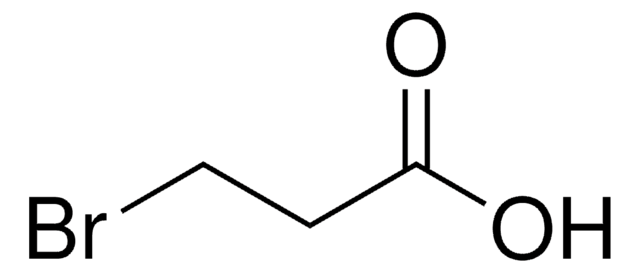Alle Fotos(1)
Wichtige Dokumente
187372
4-Benzyloxybenzylalkohol
97%
Anmeldenzur Ansicht organisationsspezifischer und vertraglich vereinbarter Preise
Alle Fotos(1)
About This Item
Lineare Formel:
C6H5CH2OC6H4CH2OH
CAS-Nummer:
Molekulargewicht:
214.26
Beilstein:
1877819
EG-Nummer:
MDL-Nummer:
UNSPSC-Code:
12352100
PubChem Substanz-ID:
NACRES:
NA.22
Empfohlene Produkte
Assay
97%
Form
solid
mp (Schmelzpunkt)
86-87 °C (lit.)
Funktionelle Gruppe
hydroxyl
phenyl
SMILES String
OCc1ccc(OCc2ccccc2)cc1
InChI
1S/C14H14O2/c15-10-12-6-8-14(9-7-12)16-11-13-4-2-1-3-5-13/h1-9,15H,10-11H2
InChIKey
OEBIVOHKFYSBPE-UHFFFAOYSA-N
Suchen Sie nach ähnlichen Produkten? Aufrufen Leitfaden zum Produktvergleich
Anwendung
4-Benzyloxybenzyl alcohol was used in the synthesis of:
- 13C-labelled derivatives of the isoflavonoid phytoestrogens, genistein, biochanin A, daidzein and formononetin
- benzyl4-(tert-butyldiphenylsiloxy-M1-carbamoyloxymethyl)phenylether
Lagerklassenschlüssel
11 - Combustible Solids
WGK
WGK 3
Flammpunkt (°F)
Not applicable
Flammpunkt (°C)
Not applicable
Persönliche Schutzausrüstung
Eyeshields, Gloves, type N95 (US)
Hier finden Sie alle aktuellen Versionen:
Besitzen Sie dieses Produkt bereits?
In der Dokumentenbibliothek finden Sie die Dokumentation zu den Produkten, die Sie kürzlich erworben haben.
Federica Tonolo et al.
Antioxidants (Basel, Switzerland), 9(2) (2020-02-06)
Due to their beneficial properties, fermented foods are considered important constituents of the human diet. They also contain bioactive peptides, health-promoting compounds studied for a wide range of effects. In this work, several antioxidant peptides extracted from fermented milk proteins
The synthesis of precisely structured polyurethanes. Part 2. Chain building methodology.
George MH, et al.
Journal of the Chemical Society. Perkin Transactions 1, 12, 1395-1401 (1996)
Synthesis of [4-13C]-Isoflavonoid Phytoestrogens.
Whalley JL, et al.
Tetrahedron, 56(3), 455-460 (2000)
Alexandre Murza et al.
Organic & biomolecular chemistry, 15(2), 449-458 (2016-12-08)
Apelin is the endogenous ligand for the G protein-coupled receptor APJ and exerts a key role in regulating cardiovascular functions. We report herein a novel series of macrocyclic analogues of apelin-13 in which the N- and C-terminal residues as well
Armine Avetisyan et al.
Neurochemistry international, 140, 104799-104799 (2020-08-14)
The receptor for advanced glycation end products (RAGE) is considered to contribute to the pathogenesis of Alzheimer's disease (AD), mediating amyloid beta (Aβ) accumulation, mitochondrial damage, and neuroinflammation. Previously, we have synthesized small peptides corresponding to the fragments (60-76) (P1)
Unser Team von Wissenschaftlern verfügt über Erfahrung in allen Forschungsbereichen einschließlich Life Science, Materialwissenschaften, chemischer Synthese, Chromatographie, Analytik und vielen mehr..
Setzen Sie sich mit dem technischen Dienst in Verbindung.








